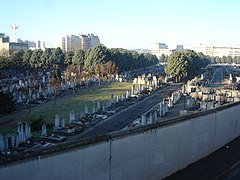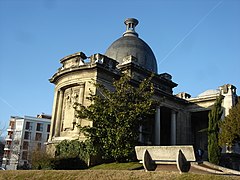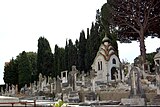Cimetières De La Guillotière
History
Before the end of the 17th century only small church cemeteries existed in Lyon. In 1695 a cemetery named "Cimitière de la Madeleine" was built to accommodate the dead from Hôtel-Dieu de Lyon. In 1807 Cimetière de Loyasse was built on Fourvière hill. These new cemeteries still did not provide enough space for the rapidly growing city, and Guillotière Cemetery was meant to alleviate the growing need for more burial spaces.
The development of Guillotière Cemetery had first been proposed on 1 March 1795 to be built at "Clos Macors", in the commune of La Guillotière, but the cemetery didn't open until 1822. When La Guillotière amalgamated with Lyon in 1852, it became the main cemetery in the city of Lyon. Despite the additional land, by 1854 the space again proved to be insufficient so the new cemetery was constructed to provide additional space for burials.
The cemetery sustained significant damage when it was mistakenly bombed by the American military during the Second World War on 26 May 1944. There is still visible damage on some of the graves at the south end of the new cemetery near rue Pierre Delore.
Design

The new cemetery is organized in concentric circles, and is the largest in the city at 18 hectares (44 acres). As of 2018, the two cemeteries together contained around 40,000 tombs.
A square of child graves, that includes 80 mini crypts, was constructed in 2015 with support from the Hospices Civils de Lyon and the city of Lyon. This construction was to create space after a similar square built in 2009 reached its capacity. The 2015 construction encompasses an area of 450 square metres (4,800 sq ft) and cost around €25,000.
The two cemeteries are separated by Avenue Berthelot and the railroad tracks connecting Perrache and Part-Dieu railway stations.
Notable interments
Several notable people are buried at the cemetery, including:
- Painter Louis-Hector Allemand, died 13 September 1886
- Automobile manufacturer Marius Berliet, died 17 April 1949
- Restaurateur and philanthropist Clotilde Bizolon, died 3 March 1940
- Pilot Élisabeth Boselli, died 25 November 2005
- Author Alphonse Bouvier, died 16 November 1931
- Politician Jules Brunard, died 25 July 1910
- Politician Jean Cagne, died 14 October 1958
- Architect Laurent de Dignoscyo, died 14 November 1876
- Checkers player René Fankhauser, died 30 March 1985
- Soldier Marius-Paul Faurax, died 19 September 1892
- Actor Georges Grey, died 2 April 1954
- Professor and Nobel Prize in Chemistry winner Victor Grignard, died 13 December 1935
- Politician Victor Lagrange, died 16 August 1894
- Cinématographe inventors Auguste and Louis Lumière, died 10 April 1954 and 6 June 1948 respectively (buried in location A6 in the new cemetery)
- Pilot and founding director of Air France Henri Lumière, died 4 October 1971
- Henri Malartre Automobile Museum founder Henri Malartre
- Television host Jacques Martin, died 2007
- General officer Benoît Meunier, died 4 January 1845
- Radio and television host Max Meynier, died 23 May 2006
- French ophthalmologist Ferdinand Monoyer, died 11 July 1912
- Inventor Jean-Claude Pompeïen-Piraud, died 24 January 1907
- Circus family Rancy (Cirque Rancy)
- Sculptor François Félix Roubaud, died 13 December 1876
- Free French Air Forces pilot Antoine Rousselot, died 22 May 1999
- Sculptor Jean Verschneider, died 1943
- Self-proclaimed prophet Eugène Vintras, died 7 December 1875
Gallery
-
The old cemetery
-
The crematorium in the new cemetery
-
Monument to the dead of the Franco-Prussian War, in the new cemetery
-
Lumière brothers' family tomb
See also
References
- ^ "Cimetière de la Guillotière et crématorium". Bibliothèque Municipale de Lyon (in French). 3 June 2006. Retrieved 9 March 2017.
- ^ Micholin, Nadine (22 June 2015). "Vente aux enchères : 1 euro, la dernière demeure". Le Progrès (in French). Retrieved 19 March 2017.
- ^ Landru, Philippe (18 January 2009). "LYON (69) : nouveau cimetière de la Guillotière". Cimetières de France et d'ailleurs (in French). Retrieved 9 March 2017.
- ^ Bertin, Dominique (2013). Guide de Lyon et ses cimitières (in French). Lyon: Lyonnaises d'Art et d'Histoire. p. 128. ISBN 978-2841473090.
- ^ Guillon, Aimé (1 January 1824). Mémoires pour servir à l'histoire de la ville de Lyon pendant la Révolution (in French). Paris: Gauthier frères. p. 335. Retrieved 9 March 2017.
- ^ Clement, Lauriane (7 August 2014). "Au cimetière de la Guillotière, à la recherche des traces du bombardement allié de 1944". Rue89Lyon (in French). Retrieved 9 March 2017.
- ^ "Fragile Memoire Catalogue illustré des clichés sur verre (sous séries 3Ph, 10Ph, 15Ph & 38 Ph) – 2éme Partie : Répertoire Numérique Sous-Série 3 PH". les Archives de Lyon (in French). Retrieved 16 March 2017.
- ^ Ring, Trudy; Watson, Noelle; Schellinger, Paul, eds. (1995). "Lyons". Northern Europe: International Dictionary of Historic Places. Vol. 2. London and New York: Routledge. p. 725. ISBN 188496401X. Retrieved 9 March 2017.
- ^ "Cimetière de la Guillotière nouveau". Site Officiel de la Ville de Lyon (in French). Grand Lyon. Archived from the original on 12 March 2017. Retrieved 21 March 2017.
- ^ "Monuments Historiques: Cimetière de la Guillotière". OnlyLyon (in French). Retrieved 8 March 2017.
- ^ Duret, Aline (22 July 2015). "À la Guillotière, la Ville aménage un cimetière pour les enfants". Le Progrès (in French). Retrieved 9 March 2017.
- ^ De Santis, Myriam. "Les Cimetières de la Guillotière (ancien et nouveau)". Lelyondesgones (in French). Retrieved 21 March 2017.
External links
- Official website of the new cemetery (in French)
- Official website of the old cemetery (in French)
- Official website of the crematorium (in French)




